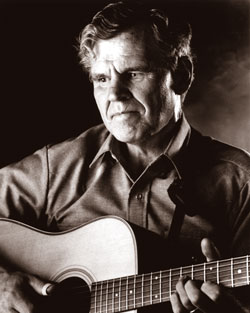Doc Watson's Deep River Blues Lesson Tutorial
 Deep River Blues is one of those traditional songs that Doc just made his own. Although known as a flat picker, playing mountain and country songs and tunes, he also had a formidable finger picking style that was sure, steady and very uniquely his own.
Deep River Blues is one of those traditional songs that Doc just made his own. Although known as a flat picker, playing mountain and country songs and tunes, he also had a formidable finger picking style that was sure, steady and very uniquely his own.Is There More Than One Way To Fingerpick Deep River Blues?
I tried to show a couple of ways to simplify Doc's fingerpicking pattern for 'Deep River' so that we can more easily approximate the sound without needing to try and duplicate the genius of his style. The trick is let the thumb strum across more than one string to add a little false syncopation. In Doc's version, he uses his finger for this, but it means that the forefinger needs to move pretty swiftly to hit all the notes with the right timing - checkout the video to see what I mean.
Of course, just like the great works of all the blues men, the timing is very important. Not only the regular spacing of notes, but the pace has to be just right, not to fast and not too slow. Another aspect of Doc's guitar work is the way in which he clips those bass notes just after striking them with his thumb. The palm of his picking hand just drops onto the strings just after hitting them so that they don't ring, but gets chokes off or damped before the note rings. It isn't completely stifled, just clipped. This gives the effect of a bouncy almost ragtime guitar feel which is very appealing.
The whole thing is made compete and unique by Doc's voice, which we can't really copy - we all have our own way of singing! For singing in general, I don't try to copy the old blues men's intonation or style - I'm British and it doesn't work for me! I think it's sufficient t play good guitar and try to pay homage to the feeling. If you don't sound like and an African American guy who played guitar on the streets for a living, don't worry about it!
Where Did The Song 'Deep River Blues' Come From?
Arthel Lane "Doc" Watson was born on March 3, 1923, in Deep Gap, North Carolina, the sixth of nine children born to Annie Greene and General Dixon Watson. He was stricken with blindness at age one as he had a birth defect in the blood vessels of his eyes, which lead to an eye infection that robbed him of his vision. Despite his disability, he staunchly refused to let it deter him from fulfilling his goals and aspirations.
Watson fell in love with music at an early age and quickly became interested in playing the guitar. In the late 1950s as interest in folk and bluegrass grew in the U.S., Watson became known as one of the hottest guitar players and banjo pickers. When comedian/banjo-player Clarence Ashley teamed up with Watson at the dawn of the 1960s, they could hardly have predicted what a profound and long lasting influence their music would have. With Ashley as a mentor, Watson, who was primarily an electric guitarist in regional rockabilly and country dancehall bands throughout the 1950s would soon be recognized for his rich voice and for being one of the most gifted acoustic guitarists in America.
Watson was like a human melting pot of music: masterful at old time mountain music, traditional folk music, and equally comfortable playing blues, bluegrass, jazz and popular music styles of the era. Watson would thrill record listeners and live audiences alike, with his flat-picking dexterity and a knack for engaging stage banter; a talent Ashley also possessed. This winning combination of talent and personality made the duo one of the shining lights of the folk and blues revivals of the early 1960s.
Between 1960 and 1962, Ashley and Watson recorded a series of albums for Folkways (later reissued as a compilation titled The Original Folkways Recordings 1960-1962) that contained a wide variety of classic old-timey folk music and blues that remains a primary inspiration to Americana roots musicians to the present day. Over the course of these classic recordings, one can clearly hear Ashley and Watson progressing forward. Although their collaboration lasted a relatively brief time they possessed a unique musical chemistry that defied generational limitations and remains vital and fresh to the present day.
This May 1967 Ash Grove performance, recorded when Watson had begun teaming up with his son Merle, is a virtual clinic on nuance and technical proficiency, as can only be exhibited by a true master of acoustic guitar technique. While some of these numbers feature the signature whiskey-soaked woebegone that connects so many to Watson, this is a remarkably upbeat performance capturing him at his jovial, upbeat best. Watson's infectious energy, undeniable joy, and jocular banter keeps the Ash Grove audience fully engaged and his voice, full and powerful, perfectly assimilates with the complex melodic picking that fuels this set.
Superb musicianship, first-rate singing that is soulful without ever becoming syrupy and songs that relay the soul of American roots music make this recording an outstanding example of Americana during the waning years of the folk and blues revivals. Watson, now in his late 80s, continues to perform and play music to the present day and remains among the greatest of American musicians -- an inspiration to many. This rare high quality recording from such a vital time in Watson's career can now be added to his many lasting contributions to American music and is yet another wonderful example of one of the most influential flat-pickers of all time. (Bershaw)
However, you play this wonderful music, it's sure that you'll grow just be listening to Doc's rendition of Deep River. If you pick up one lick or riff, or understand how this great sense of fingerstyle pace can be , then the study will be more than worth it. Doc was playing right up until he died at 82, which is in itself a great testimony to how we should approach our guitar music.
